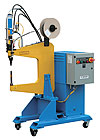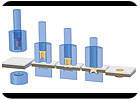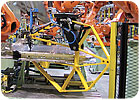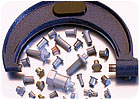

Self-pierce rivets from Henrob were the optimal fastening solution. The fasteners provide consistent joint performance. They can join dissimilar materials, they can be used with adhesives, and installation can be fully automated. During the design phase, Henrob helped the manufacturer minimize the number of variants in hard tooling and consumables. Servo-electric riveting systems were incorporated into the manufacturer’s newly automated production line, and hydraulic riveters were used in the manual subassembly stations.
Self-pierce riveting has been around since the early 1960s. It is a cold joining process for fastening two or more sheets of material by driving a rivet through the top sheets and upsetting it, under the influence of a die, into the bottom sheet without breaking through it. The technology can join a stack of aluminum sheets up to 12 millimeters thick or a stack of steel sheets up to 6 millimeters thick.
Self-pierce riveting is an excellent alternative to welding. Welding requires significant energy and heat, and problems with weld porosity can compromise the strength of the joint. In contrast, self-pierce riveting does not transmit heat to the product. It forms strong, fatigue-resistant joints without affecting intermediate layers or distorting the materials. Self-pierce riveting requires minimal power, so it’s environmentally friendly, too.
The process joins dissimilar materials, as well as materials that have been lubricated, painted, coated or plated. Self-pierce riveting can be used on joints that include sealants, adhesives or insulation. The process can join high-strength steel, galvanized steel, aluminum, plastics, such as nylon and polypropylene, and composites, such as sheet molding compound.
Because self-pierce riveting does not require prepunched or predrilled holes, assemblers can save overall manufacturing time compared with blind rivets and other fasteners. This lack of a through-hole also ensures a leak-proof joint.
A self-pierce riveting system requires access to both sides of the assembly, but many configurations are available to reach most applications that aren’t truly blind. A common misperception about self-pierce riveting is that it can only be used with small C-frames. In fact, Henrob has supplied robot-mounted tools with a throat depth of more than 4 feet for a major truck manufacturer. Floor-mounted tools can be even larger. Gang-mounted tools, E-frames, O-frames and other specially designed configurations are also available.
The basic components of a self-pierce riveting system are a hydraulic or servo-electric power pack and controller, and the riveting tool assembly. C-, O-, H-, E- or G-frames are used to mount the rivet setter and maintain alignment with the upsetting die. Tools are customized to access most any area of an assembly. For example, an electronics busway is assembled with two preclamping rivet setters mounted in an O-frame. The riveters simultaneously insert two 5-millimeter countersunk rivets, fed from spools. The long-nose setters access the narrow troughs at the base of parallel sections.
Manual systems can be just as flexible. Manual setups are dictated by ergonomic reasons, such as part weight. The rivet setter assembly can be suspended from an overhead tool balancer. Alternatively, the riveting equipment can be mounted to a pedestal, and the parts can be presented manually or robotically. A boat manufacturer uses a 600-millimeter C-frame and overhead suspension system to allow manual, three-axis articulation of the riveting tool, which includes a long-stroke setter. Two-hand actuation ensures operator safety.
Various methods, such as sprocket tape and blow-feeding, are used to automatically supply rivets to the setter. The choice of feeding method depends on the production volume, assembly process and application. To further increase cycle time, the rivet setter can be adjusted so that it does not retract all the way back when setting multiple rivets consecutively.
Self-pierce rivets are usually made from high-quality grades of steel wire that have been forged, hardened and tempered to provide optimum joint properties. They can also be made from austenitic or martensitic stainless steel, copper, or aluminum when joining soft grades of aluminum material. A variety of head styles are available to meet functional or aesthetic requirements. Even studs and T-studs are available.

Maximizing Quality and Productivity
With spot welding, engineers can have difficulty determining joint quality without destructive testing. In contrast, joints made with self-pierce rivets can be checked visually. Measurement with a head height gauge plus a quick visual check of the protrusion on the tail side is enough to show that a riveted joint has been formed correctly.If more detail is needed, a computerized monitoring system can be integrated into the rivet setting equipment. The monitoring system provides real-time analysis of riveting parameters, such as setting force and displacement. If the parameters fall outside of predefined tolerances during rivet insertion, the system alerts the operator. The system can be configured to retain historical data to identify trends, which can help with preventive maintenance.
There are no consensus industry standards for self-pierce riveting. For maximum performance, assemblers should have their riveting equipment and rivets engineered for their specific application. This up-front planning can result in more efficient assembly, minimal part numbers, and a lower-cost joint design.
For example, a tool box manufacturer needed to join aluminum diamond plate to various combinations of aluminum, steel and stainless steel sheets. Using self-pierce riveting, the manufacturer was able to join many different material combinations and thicknesses using just two different rivets and dies.
Similarly, an appliance manufacturer had considered using adhesives and clinching to join prepainted steel to uncoated steel. However, the company did not pursue this method, because variations in material thickness complicated the manufacturing process. The company now uses self-pierce riveting in an automated workcell for left-hand and right-hand parts. A single rivet type is used with different dies to accommodate thin and thick joints. Fourteen rivets per cabinet are set with 10 dual-user power packs running 20 riveting tools (10 per side). The flexibility of the system allowed a reduction in fastener part numbers while satisfying strength and appearance needs and accommodating all joint thickness requirements. Using only one rivet type also eliminated the possibility of rivets being loaded into the wrong tool.
Up-front planning can also lead to a custom solution. For example, a dishwasher manufacturer needed to join a 2.2-millimeter-thick plastic sheet, which tended to vary considerably in thickness, to a 1.2-millimeter-thick sheet of galvanized steel. For this application, the company uses a 300 series stainless steel self-pierce rivet with a special trifurcating die. The rivet pierces both materials and is then split into three “legs” on the tail side. Modifications to the die minimized material draw-down during riveting and prevented sharp edges on the tail side of the joint. The result is consistent high-strength joints, despite thickness variations in the material.

Can You Use Self-Pierce Riveting?
If you need fast, efficient assembly, low in-place costs, and fasteners that provide high performance, self-pierce riveting should be considered. Self-pierce riveting is also an excellent solution when welding the assembly is problematic or when aesthetics are important. The rivet head can be raised or flush, while the tail side will have a protrusion of 1 to 3 millimeters, depending on the rivet size.
Two conditions are required: access to both sides of the application, and a minimum surface area to fasten, depending on rivet size.
Joint design considerations for self-pierce riveting include:
* Preferably, brittle material should not be used for the bottom sheet.
* If possible, the bottom sheet should be ductile with an elongation factor above 12 percent.
* Fastening through thin or soft materials and into a thick or hard material is preferred. However, as a rule of thumb, if the joint must be riveted through a thick material and into a thin material, this can be done if the bottom sheet is approximately one-third of the total stack thickness.
Today, self-pierce riveting is used by a range of manufacturers, from local metal fabricators using simple manual systems to international heavy equipment manufacturers with fully automated robotic cells. Yet, all of them realize the benefits of the process: Self-pierce riveting lowers in-place costs and provides a strong, resistant joint.